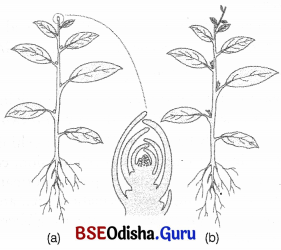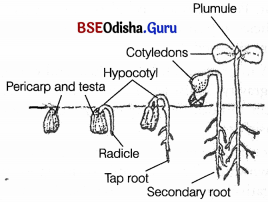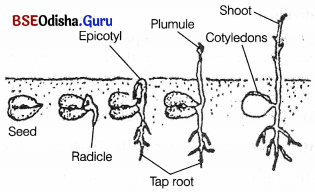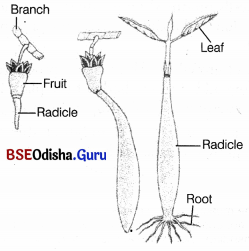Odisha State Board CHSE Odisha Class 11 Biology Solutions Chapter 15 Plant Growth and Development Textbook Questions and Answers.
CHSE Odisha 11th Class Biology Chapter 15 Question Answer Plant Growth and Development
Plant Growth and Development Class 11 Questions and Answers CHSE Odisha
Very Short Answer Types Questions
Multiple choices questions
Question 1.
Gibberellic acids show which of the following physiological effects:
(a) yellowing of young leaves
(b) elongation of genetically dwarf plants
(c) shortening of genetically tall plants
(d) yellowing of old leaves
Answer:
(b) elongation of genetically dwarf plants
Question 2.
What will happen when the dark period of short day plants is interrupted by a flash of light?
(a) flower immediately
(b) will not flower
(c) induce more flowering
(d) converts to a long day plant
Answer:
(b) will not flower
Question 3.
The plant hormone connected primarily with cell division is
(a) IAA
(b) NAA
(c) Kinetin
(d) GA
Answer:
(c) Kinetin
Question 4.
Apical dominance is influenced by
(a) GA
(b) Ethylene
(c) Auxin
(d) Coumarine
Answer:
(c) Auxin
Question 5.
Abscisic acid causes
(a) stomatal closure
(b) leaf expansion
(c) root formation
(d) stem elongation
Answer:
(a) stomatal closure
Question 6.
Richmond-Lang effect is due to
(a) auxin
(b) abscisic acid
(c) cytokinin
(d) ethylene
Answer:
(c) cytokinin
Question 7.
Auxin transport is
(a) polar
(b) non-polar
(c) symplastic
(d) apoplastic
Answer:
(a) polar
Fill in the blanks
Question 1.
Fruit ripening is induced by the hormone ……….. .
Answer:
ethylene
Question 2.
Mangrove plants generally show …………. type of germination.
Answer:
viviparous
Question 3.
Florigen is associated with …………. .
Answer:
flowering
Question 4.
The amino acid ………….. is the precursor of ethylene.
Answer:
methionine
Short Answer Type Questions
Question 1.
Apical dominance
Answer:
Auxins perform several functions, these are as follows
(i) Apical Dominance Presence of auxin in higher , concentration (in higher plants) in shoot apex, promotes apical dominance. It is seen commonly in many vascular plants, that presence of apical buds does not allow the lateral buds to grow. They only start developing into branches when the apical bud is removed.

Apical dominance in plants (a) A plant with apical bud intact (b) A plant with apical bud removed
(ii) Initiation of Roots In contrast to stem, higher concentration of auxin inhibits the elongation of shoots, but it initiates more lateral branches of roots.
(iii) Inhibition of Abscission Natural auxins delay abscission of young fruits and leaves and also used to control pre-harvest fruit drop.
(iv) Cell Elongation Auxin stimulates the elongation of cells of shoots.
(v) Promotes Flowering Presence of auxin helps in promoting flowering in some plants, e.g., pineapple, litchi, etc.
(vi) Metabolism Application of auxin can enhance metabolism due to mobilisation of nutrients and growth promoting substances.
Question 2.
Seed dormancy
Answer:
In majority of angiospermic plants, seeds remain in an inactive state and germinate only after a specific period of rest or dormancy.
Thus, dormancy may be defined as, ‘the inactive state of the seed in which growth of the embryo is temporarily suspended for a specific length of time’.
This state of inactivation may be due to some internal factors that inhibit the process of germination. The period of dormancy varies in all the plants.
On the contrary, cereals germinate immediately after harvest and seeds of citrus germinate in situ.
Question 3.
Vernalisation
Answer:
Beside light, the temperature also affects the flowering and other vital phenomenon of plants. It has been observed that there are some plants which do not flower until they are not exposed to low temperature, i.e., thdy depend either qualitatively or quantitatively on exposure to low temperature to flower.
This chilling requirement of the plants for flowering is known as vernalisation. It prevents the precocious reproductive development late in the growing season, enabling plant to have sufficient time to reach the level of maturity.
Long Answer Type Questions
Question 1.
Describe the different types of seed germination.
Answer:
Seed Germination
It is the process by which the dormant embryo of the seed resumes active growth and forms a seedling. It is an irreversible process during which radicle grows out first to establish root. After that, plumule grows to form shoot.
Germination may be of three types
(i) Epigeal Germination
In this type of germination, cotyledons are pushed out of the soil. The cotyledons become green and also perform photosynthesis in addition to food storage.
In dicots, this happens due to the elongation of hypocotyl (stem of germinating seedling between cotyledons and radicle), e.g. bean, castor, mustard, tamarind, sunflower, etc.

Epigeal germination
(ii) Hypogeal Germination
In this type of germination, the cotyledons do not come out of the soil and remain underground. The epicotyl (part of embryonic axis between plumule and cotyledons) elongates first to raise the first leaves out of the soil. The hypocotyl growth is restricted, e.g. all monocots (e.g. rice, maize, wheat, etc) and dicots such as gram, pea, mango, groundnut, etc.

Hypogeal Germination of gram
(iii) Viviparous Germination
It is a special type of germination found growing-in salty lakes, sea coasts and deltas, i.e. in mangrove plants.

Germination in vivipary plants
In this process, seed germinates while still attached to the parent plant.
The radicle elongates considerably and projects out of the fruit while its lower part becomes thick and swollen. Finally, the seedling breaks of the parent plant due to its increasing weight and gets embedded in the muddy soil below.
The lateral roots develop soon at the basal end of the radicle.
It is also called aerial germination, e.g. Rhizophora, Ceriops, Avicennia, etc.
Factors Affecting Seed Germination:
Seed germination is directly affected by various factors. These are as follow:
1. Water
It is very essential as seed cannot germinate unless sufficient amount of water is available. Water is important because
- It activates the enzymes which digest the complex reserve food of the seed.
- It maintains the turgidity of the embryonal cells and helps in cell elongation.
- It helps in the rupturing of the seed coat.
- It is the medium for all physiological processes.
2. Oxygen
It is needed in sufficient quantity for germination.
The seed is activated on absorbing water and carries an aerobic respiration at a higher rate, so a lot of O2 is consumed. Thus, O2 is essential for respiration and all other physiological activities.
3. Temperature
Suitable temperature is a necessity for germination as a number of physiological processes occur within seed.
The range of optimum temperature varies greatly in different types of seeds. However, most of the seeds fail to germinate below 0°C and above 50°C. The optimum temperature is 25-30°C in most plants.
4. Light
Most of the plants do not require light for germination. Thus, it is not considered as an essential factor. The effect of light on different seeds led to their categorisation into the three groups as given below:
- Positively Photoblastic These seeds require light for germination, e.g. lettuce.
- Negatively Photoblastic These seeds do not require light for germination (i.e. total darkness is needed). If kept under lighted conditions, they do not germinate, e.g. pumpkin.
- Photoblastic Neutral These seeds germinate equally well under dark as well as in light conditions, e.g. cultivated plants like cucumber, tomato, etc.
Question 2.
Give an account of physiological effects of auxins in plants.
Answer:
Auxins
Auxin (Gk. auxein to grow) was initially isolated from the urine of human, but later on, their presence was also found in plants and was proved to be the first PGR ever known. The real plant auxin is chemically known as Indole -3-Acetic Acid (IAA). The term is also applied to other natural and synthetic compounds having various growth regulating properties. Production of auxin generally takes place in the region of growing apices of the stems and roots from where they migrate to the site of their action.
Note Auxins can move only through cell to cell by diffusion, i.e., they cannot move through vascular tissues.
Types of Auxins:
There are generally two basic categories in which auxins are divided
(i) Natural Auxins
It occurs naturally in plants and fungi, e.g., Indole Acetic Acid (IAA) and Indole Butyric Acid (IBA).
(ii) Synthetic Auxins
These are prepared from synthetic compounds that cause several responses to IAA. They can easily move in all directions inside the plants, e.g., Naphthalene Acetic Acid (NAA), 2, 4- dichlorophenoxyacetic acid (2, 4-D).
All these types of auxins are extensively been used in agricultural and horticultural practices.
Functions of Auxins:
Auxins perform several functions, these are as follows
(i) Apical Dominance Presence of auxin in higher , concentration (in higher plants) in shoot apex, promotes apical dominance. It is seen commonly in many vascular plants, that presence of apical buds does not allow the lateral buds to grow. They only start developing into branches when the apical bud is removed.

Apical dominance in plants (a) A plant with apical bud intact (b) A plant with apical bud removed
(ii) Initiation of Roots In contrast to stem, higher concentration of auxin inhibits the elongation of shoots, but it initiates more lateral branches of roots.
(iii) Inhibition of Abscission Natural auxins delay abscission of young fruits and leaves and also used to control pre-harvest fruit drop.
(iv) Cell Elongation Auxin stimulates the elongation of cells of shoots.
(v) Promotes Flowering Presence of auxin helps in promoting flowering in some plants, e.g., pineapple, litchi, etc.
(vi) Metabolism Application of auxin can enhance metabolism due to mobilisation of nutrients and growth promoting substances.
Applications of Auxins:
As stated, use of synthetic auxins is widely accepted now-a-days in various agricultural and horticultural practices.
Following are the applications of auxins
- Eradication of Weeds Auxins are used as weedicides and herbicides. Application of 2, 4-dichlorophenoxyacetic acid (2, 4-D) is widely done in order to kill dicotyledonous weeds. It does not affect mature, monocotyledonous plants.
- Parthenocarpy Auxins are sprayed on to the unpollinated pistil and make them develop into parthenocarpic fruits, which carry a better market values.
Question 3.
Discuss the physiological effects of gibberellings in plants.
Answer:
Gibberellins:
These are another group of plant growth regulators, which are known to be weakly acidic growth hormones. There are more than 100 different gibberellins reported from widely different organisms like fungi and higher plants.
All of them are known to be acidic in nature, thus, they are termed as Gibberellic Acids (i.e., GA, GA1, GA2 and so on). However, GA3 is the most important gibberellic acid which was first to be discovered. It is most extensively studied amongst all gibberellins.
Functions of Gibberellins:
Gibberellins show various important physiological effects
- Elongation of Intemodes It helps in elongation of the internodes so as to increase the height of the plant. They cause an increase in length of axis and is also used in increasing length of grapes stalks.
- Elongation of Genetically Dwarf Plants It has been seen that if gibberellins are administered to a dwarf plant (pea, maize, etc), it may help in overcoming dwarfism. It also causes fruits to elongate and improve their shape, e.g., in apples, etc.
- Bolting The gibberellins also helps in promoting bolting (internode elongation) just prior to their reproductive phase or flowering. If gibberellin is sprayed on rosette plants like beet, cabbage as these plants will show extensive internodal growth and profuse leaf development.
- Breaking Dormancy It also helps in overcoming natural dormancy in buds, tubers, seeds, etc., and helps them to grow.
Seed is said to be in the dormant state when it remains dry and non-germinating even if all conditions for germination are available, Thus, by ‘breaking seed dormancy’, we simply mean, to induce the
germination in seeds. - Flowering This can also be induced in long day plants by the action of gibberellins.
Applications of Gibberellins
Gibberellins, apart from showing,varied physiological effects, also have numerous applications.
These are as follows
- Delays Senescence Gibberellins can delay the ripening of fruits such as in Citrus, apples, etc. This can also be used for safe and prolonged storage of the fruits.
- Malting Process The process of malting in brewing industry can be speeded up by the use of GA3.
- Sugar Yield As carbohydrate is stored in the form of sugar in the stems of sugarcane. Thus, if crop of sugarcane is sprayed with gibberellins. It results in increased internodal length of the stem. This, enhances the increase in the yield of sugarcane as much as 20 tonnes per acre.
- Early Seed Production When sprayed on juvenille conifers, like Cycas and Pinus gibberellins hasten the maturity period of them leading to early seed production.
